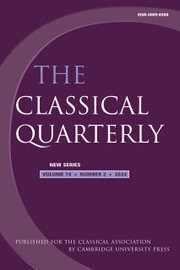No CrossRef data available.
Article contents
THE DECLINE OF SOPHIA AND A MISLEADING GLOSS IN PLOTINUS, ENN. II.9 [33].10.25
Published online by Cambridge University Press: 01 June 2016
Extract
In two chapters of Enn. II.9 [33], Plotinus discusses the Gnostic idea that the creation of the world is due to the ‘decline’ (νεῦσις) of a principle that he variously calls Soul or Sophia. The identity of Plotinus' Gnostics is notoriously difficult to establish with any degree of precision; I can only note here that the idea of Sophia's ‘decline’ features in a number of extant Gnostic texts, such as those from Nag Hammadi and the Berlin Codex (Papyrus Berolinensis 8502), as a recent survey of the evidence by Poirier has demonstrated.
Information
- Type
- Shorter Notes
- Information
- Copyright
- Copyright © The Classical Association 2016
References
1 I capitalize ‘Soul’ in the following, to indicate that the discussion deals with the world soul, rather than with particular individual souls. Plotinus, without argument, takes the world soul's activity of administering the universe to be comparable to that of the Gnostic Sophia, who ‘illuminates’ a pre-existing material substrate. See, for example, Enn. II.9.4.1-22, where the subject of Sophia's fall and decline is explained entirely in terms of Soul.
2 See Poirier, P.-H., ‘À propos de la νεῦσις dans les textes de Nag Hammadi’, Laval théologique et philosophique 68 (2012), 619–26CrossRefGoogle Scholar. Particularly interesting in the present context is the Nag Hammadi treatise Zostrianos, where we find the claim that Sophia ‘emitted the darkness’ (trans. Turner) (NHC VIII,1: 9.17), which may perhaps be related to the darkness which the Soul is said to ‘illuminate’ at Enn. II.9.10.25. Further, we find in Zostrianos the view that Sophia's ‘looking down’ is the reason why some immortal souls ‘associate’ with various types of incarnate souls (27.9-13). The thought that Sophia/Soul is the cause for the descent of particular souls is also implied by Enn. II.9.10.24-5, where Plotinus refers to ‘the Soul for whose sake the other souls descended’.
3 See for example Enn. III.8.4.39-40. The same idea recurs in treatise II.9, e.g. at the end of chapter 2 (lines 16–18). The two treatises are often thought to be part of a larger composition, the so-called Großschrift, originally comprising Enn. III.8 [30], V.8 [31], V.5 [32] and II.9 [33], and later somewhat arbitrarily divided by Plotinus' editor Porphyry. Cf. Harder, R., ‘Eine neue Schrift Plotins’, Hermes 71 (1936), 1–10 Google Scholar.
4 Inserting εἶναι after μέλη in line 22 with Theiler.
5 St Paul describes the faithful as ‘members’ of Christ's body (Eph. 5:30). In the case of the Gnostics, the idea of ‘being a member’ of Sophia is perhaps to be explained in terms of the supposedly pneumatic nature of their souls, which are made of the same element as Sophia herself. See e.g. Irenaeus, Adv. Her. I.6.1-2.
6 Reading τὸ σκότος in place of τῷ σκότῳ, with Heigl and Kirchhoff; an accusative object seems to be required, as in 11.1-2.
7 The view that the Soul shapes or ‘illuminates’ matter is not far removed from Plotinus' own position, which may partly explain why he here revisits the topic. On the illumination of matter by Soul, see for example I.8 [51].14.38-9. It is connected to the fall of the Soul in the same treatise (14.40-8). See also I.1 [53].12.21-8 on the same subject, and the lucid discussion in J. Rist, Plotinus: The Road to Reality (Cambridge, 1967), ch. 9.
8 Plotinus also describes the Demiurge as an ‘image of the image’ (II.9.10.27: τοῦ εἰδώλου εἴδωλον), most likely on the grounds that the lower Soul/Sophia which declined and which creates the image in matter (the Demiurge) is itself an image of the higher Sophia that remains in the Gnostic Pleroma (cf. II.9.12.10: εἴδωλον ὑλικόν). The distinction between higher and lower Sophia is not generally made explicit in Plotinus' presentation, a fact that adds to it an extra layer of complexity.
9 This contradiction is clearly seen by K. Alt, Philosophie gegen Gnosis: Plotins Polemik in seiner Schrift II.9 (Stuttgart, 1990), 51 (‘Es zeigt sich ein klarer Widerspruch …’). It is also noted by R. Dufour (in L. Brisson, R. Dufour, J. Laurent and J.-F. Pradeau [edd.], Plotin: Traités 30–37 [Paris, 2006], 268 n. 200), who makes the suggestion that the confusion in Plotinus' account may be due to syncretism between Valentinian and Sethian Gnostic beliefs. See also J. Igal, Plotino Enéadas I-II (Madrid, 1982), 517 n. 107.
10 I am grateful to the anonymous reviewer for pressing me on this point.
11 See Enn. II.9.4.6-11.
12 See Alt (n. 9), 52 (‘Die beiden Aussagen beziehen sich auf zwei Phasen im selben valentinianischen Mythos.’).
13 A difficulty with the Gnostic account put forward here is where the individual souls are meant to go, given that the decline of Soul/Sophia and the attendant descent of individual souls precede the creation of the universe by the Demiurge, so that there would appear to be nowhere anything could descend to. Plotinus himself points out a similar problem with Soul's decline at Enn. II.9.12.40-2.
* Permission to reproduce excerpts taken from PLOTINUS Ennead II.9: Against the Gnostics by Dr. Sebastian Gertz, Parmenides Publishing (2016), has been granted by the publisher.

